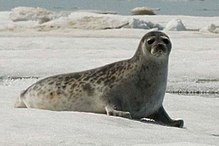
Back فقمة حلقية Arabic فقمه حلقيه ARZ Spedol (Pusa hispida) AVK Halqaşəkilli suiti Azerbaijani حلقهلی سۇ ایتی AZB Кольчатая нерпа Byelorussian Пръстенчат тюлен Bulgarian Reunig kelc'hennek Breton Foca ocel·lada Catalan Pusa hispida CEB
| Ringed seal | |
|---|---|

| |
| Scientific classification | |
| Domain: | Eukaryota |
| Kingdom: | Animalia |
| Phylum: | Chordata |
| Class: | Mammalia |
| Order: | Carnivora |
| Clade: | Pinnipedia |
| Family: | Phocidae |
| Genus: | Pusa |
| Species: | P. hispida
|
| Binomial name | |
| Pusa hispida (Schreber, 1775)
| |

| |
| Synonyms | |
|
Phoca hispida
| |
The ringed seal (Pusa hispida) is an earless seal inhabiting the Arctic and sub-Arctic regions. The ringed seal is a relatively small seal, rarely greater than 1.5 m in length, with a distinctive patterning of dark spots surrounded by light gray rings, hence its common name. It is the most abundant and wide-ranging ice seal in the Northern Hemisphere, ranging throughout the Arctic Ocean, into the Bering Sea and Okhotsk Sea as far south as the northern coast of Japan in the Pacific and throughout the North Atlantic coasts of Greenland and Scandinavia as far south as Newfoundland, and including two freshwater subspecies in northern Europe. Ringed seals are one of the primary prey of polar bears and killer whales, and have long been a component of the diet of indigenous people of the Arctic.
Ringed seals are the smallest and most abundant member of the seal family that live in the Arctic and Sub-Arctic regions. The average life span of a ringed seal is 40 years, with a diet based mainly on Arctic cod and planktonic crustaceans. Typically about 1.5 metres (5 ft) long, the ringed seal is known to be solitary with their main predator being polar bears. Recently, however, the biggest threat to ringed seals has been the changing temperature in the Arctic and the detrimental changes to sea ice that follow. With declines in snowpack and sea ice due to warming ocean and atmospheric temperatures, survival has become tougher for ringed seals in the Arctic and Sub-Arctic regions. Yet ringed seals are also potentially projected to thrive due to warming, considering the early extinction of their predators.
- ^ Lowry, L. (2016). "Pusa hispida". IUCN Red List of Threatened Species. 2016: e.T41672A45231341. doi:10.2305/IUCN.UK.2016-1.RLTS.T41672A45231341.en. Retrieved 13 November 2021.
- ^ "Pusa hispida". NatureServe Explorer. Retrieved 17 April 2024.
© MMXXIII Rich X Search. We shall prevail. All rights reserved. Rich X Search

